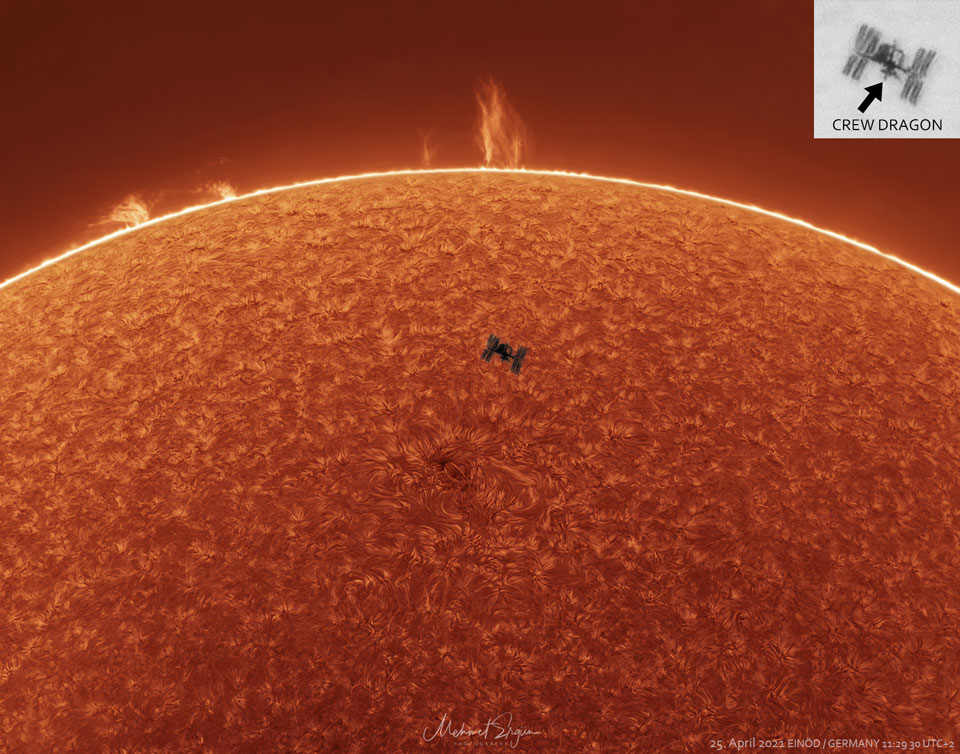19. November 2023
太空站、日珥、太陽

探索宇宙1!逐工會揀一幅無仝款 ê 影像抑是相片,𤆬你熟似咱這个迷人 ê 宇宙,閣有專業天文學者2為你3解說4。
- 原始文章:Space Station, Solar Prominences, Sun
- 影像來源 kah 版權:Mehmet Ergün
- 來追蹤 APOD ê Instagram:Arabic, English, Persian, Portuguese, 抑是 台文版
- 台文翻譯:An-Li Tsai (NSYSU)
[漢羅] 太空站、日珥、太陽
這毋是 太陽烏子啦! 這是 國際太空站 (ISS) tī 太陽面頭前行過 ê 時陣去予翕著 ê。 若是 太陽烏子,to̍h 會有一个較暗 ê 中央 本影 kah 一个較光 ê 半影,而且 袂有天龍號太空船停 tī 遐。 毋閣,ISS 是一个足複雜多變 ê 機械。 伊是 人類 歷史上上大 上複雜 ê 太空船之一。 而且,太陽烏子踅 太陽,ISS 踅 地球。 Tùi ISS 來講,ùi 太陽面頭前行過是一件真四常 ê 代誌。 伊每 90 分鐘踅地球一輾。 毋閣愛 ùi 一幅 大張圖 內底提著伊 ê 位置、時間、kah 設備 ê 資訊,較無簡單。 這張影像 是 kā 三張影像敆做伙,三張攏 tī 仝一位、差不多仝一个時間翕--ê。 第一張影像感光傷超過矣,煞翕著太陽面頂一寡足暗 ê 日珥。 第二張影像感光無夠,煞翕著 太陽色球層 ê 複雜花逝。 第三張影像是上困難翕著 ê,是翕著太空站 tī 無夠一秒鐘 ê 時間內底 行過 太陽面頭前。 咱若是 斟酌來看 太空站 ê 外形,to̍h 會看著停 tī 遐 ê 天龍號太空船。
[POJ] Thài-khong-chām, Ji̍t-jíⁿ, Thài-iông
Che m̄-sī thài-iông o͘-chú la̍h! Che sī Kok-chè-thài-khong-chām (ISS) tī thài-iông bīn-thâu-chêng kiâⁿ-kòe ê sî-chūn khì hō͘ hip--tio̍h-ê. Nā-sī thài-iông o͘-chú, to̍h ē ū chi̍t-ê khah-àm ê tiong-ng pún-iáⁿ kah chi̍t-ê khah-kng ê pòaⁿ-iáⁿ, jî-chhiáⁿ bōe ū Thian-lêng-hō thài-khong-chûn thêng tī hiah. M̄-koh, ISS sī chi̍t-ê chiok ho̍k-cha̍p to-piàn ê ki-hâi. I sī jîn-lūi le̍k-sú-siōng siōng tōa siōng ho̍k-cha̍p ê thài-khong-chûn chi-it. Jî-chhiáⁿ, thài-iông o͘-chú se̍h Thài-iông, ISS se̍h Tē-kiû. Tùi ISS lâi-kóng, ùi thài-iông bīn-thâu-chêng kiâⁿ-kòe sī chit-kiāⁿ chin sù-siông ê tāi-chì. I múi káu-cha̍p hun-cheng se̍h Tē-kiû chi̍t-liàn. M̄-koh ài ùi chit-pak tōa tiuⁿ tô͘ lāi-té the̍h-tio̍h i ê ūi-tì, sî-kan, kah siat-pī ê chū-sìn, khah bô kán-tan. Chit-tiuⁿ iáⁿ-siōng sī kā saⁿ-tiuⁿ iáⁿ-siōng kap chòe-hóe, saⁿ-tiuⁿ lóng tī kāng-chit-ūi, chha-put-to kāng chi̍t-ê sî-kan hip--ê. Tē-it-tiuⁿ iáⁿ-siōng kám-kng siūⁿ chhiau-kòe ah, soah hip-tio̍h thài-iông bīn-téng chi̍t-kóa chiok-àm ê jī-jíⁿ. Tē-jī-tiuⁿ iáⁿ-siōng kám-kng bô-kàu, soah hip-tio̍h thài-iông sek-kiû-chân ê ho̍k-cha̍p hoe-chōa. Tē-saⁿ-tiuⁿ iáⁿ-siōng sī siōng khùn-lân hip-tio̍h ê, sī hip-tio̍h thài-khong-chām tī bô-kàu chi̍t-bió-cheng ê sî-kan lāi-té kiâⁿ-kòe thài-iông bīn-thâu-chêng. Lán nā-sī chim-chiok lâi khòaⁿ thài-khong-chām ê gōa-hêng, to̍h ē khòaⁿ-tio̍h thêng tī hiah ê Thian-lêng-hō thài-khong-chûn.
[KIP] Thài-khong-tsām, Ji̍t-jínn, Thài-iông
Tse m̄-sī thài-iông oo-tsú la̍h! Tse sī Kok-tsè-thài-khong-tsām (ISS) tī thài-iông bīn-thâu-tsîng kiânn-kuè ê sî-tsūn khì hōo hip--tio̍h-ê. Nā-sī thài-iông oo-tsú, to̍h ē ū tsi̍t-ê khah-àm ê tiong-ng pún-iánn kah tsi̍t-ê khah-kng ê puànn-iánn, jî-tshiánn buē ū Thian-lîng-hō thài-khong-tsûn thîng tī hiah. M̄-koh, ISS sī tsi̍t-ê tsiok ho̍k-tsa̍p to-piàn ê ki-hâi. I sī jîn-luī li̍k-sú-siōng siōng tuā siōng ho̍k-tsa̍p ê thài-khong-tsûn tsi-it. Jî-tshiánn, thài-iông oo-tsú se̍h Thài-iông, ISS se̍h Tē-kiû. Tuì ISS lâi-kóng, uì thài-iông bīn-thâu-tsîng kiânn-kuè sī tsit-kiānn tsin sù-siông ê tāi-tsì. I muí káu-tsa̍p hun-tsing se̍h Tē-kiû tsi̍t-liàn. M̄-koh ài uì tsit-pak tuā tiunn tôo lāi-té the̍h-tio̍h i ê uī-tì, sî-kan, kah siat-pī ê tsū-sìn, khah bô kán-tan. Tsit-tiunn iánn-siōng sī kā sann-tiunn iánn-siōng kap tsuè-hué, sann-tiunn lóng tī kāng-tsit-uī, tsha-put-to kāng tsi̍t-ê sî-kan hip--ê. Tē-it-tiunn iánn-siōng kám-kng siūnn tshiau-kuè ah, suah hip-tio̍h thài-iông bīn-tíng tsi̍t-kuá tsiok-àm ê jī-jínn. Tē-jī-tiunn iánn-siōng kám-kng bô-kàu, suah hip-tio̍h thài-iông sik-kiû-tsân ê ho̍k-tsa̍p hue-tsuā. Tē-sann-tiunn iánn-siōng sī siōng khùn-lân hip-tio̍h ê, sī hip-tio̍h thài-khong-tsām tī bô-kàu tsi̍t-bió-tsing ê sî-kan lāi-té kiânn-kuè thài-iông bīn-thâu-tsîng. Lán nā-sī tsim-tsiok lâi khuànn thài-khong-tsām ê guā-hîng, to̍h ē khuànn-tio̍h thîng tī hiah ê Thian-lîng-hō thài-khong-tsûn.
[English] Space Station, Solar Prominences, Sun
That's no sunspot. It's the International Space Station (ISS) caught passing in front of the Sun. Sunspots, individually, have a dark central umbra, a lighter surrounding penumbra, and no Dragon capsules attached. By contrast, the ISS is a complex and multi-spired mechanism, one of the largest and most complicated spacecraft ever created by humanity. Also, sunspots circle the Sun, whereas the ISS orbits the Earth. Transiting the Sun is not very unusual for the ISS, which orbits the Earth about every 90 minutes, but getting one's location, timing and equipment just right for a great image is rare. The featured picture combined three images all taken from the same location and at nearly the same time. One image -- overexposed -- captured the faint prominences seen across the top of the Sun, a second image -- underexposed -- captured the complex texture of the Sun's chromosphere, while the third image -- the hardest to get -- captured the space station as it shot across the Sun in a fraction of a second. Close inspection of the space station's silhouette even reveals a docked Dragon Crew capsule.
詞彙學習
| 漢羅 | POJ | KIP | 華語 | English |
|---|---|---|---|---|
| 日珥 | ji̍t-jíⁿ | ji̍t-jínn | 日珥 | solar prominences |
| 太陽烏子 | thài-iông o͘-chú | thài-iông oo-tsú | 太陽黑子 | sunspot |
| 本影 | pún-iáⁿ | pún-iánn | 本影 | central umbra |
| 半影 | pòaⁿ-iáⁿ | puànn-iánn | 半影 | penumbra |
| 國際太空站 | Kok-chè-thài-khong-chām | Kok-tsè-thài-khong-tsām | 國際太空站 | International Space Station (ISS) |
| 色球層 | sek-kiû-chân | sik-kiû-tsân | 色球層 | chromosphere |
| 天龍號太空船 | Thian-lêng-hō thài-khong-chûn | Thian-lîng-hō thài-khong-tsûn | 天龍號太空船 | Dragon Crew capsule |